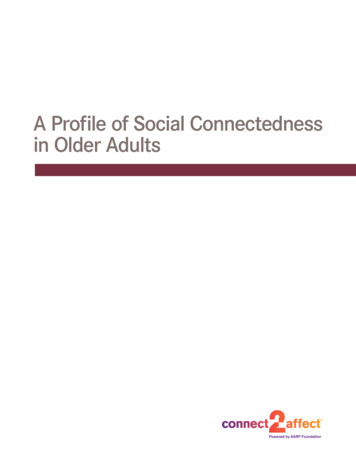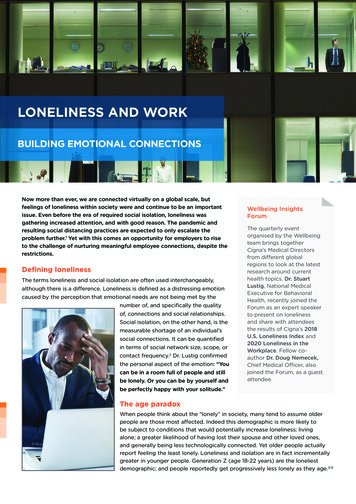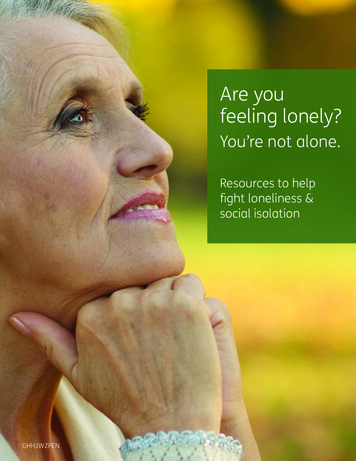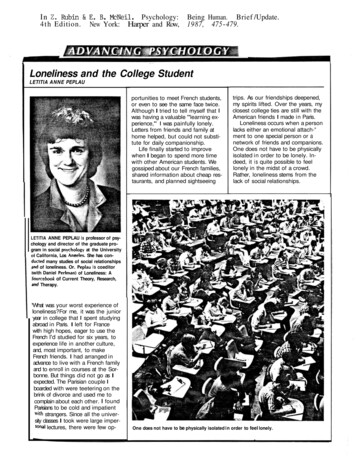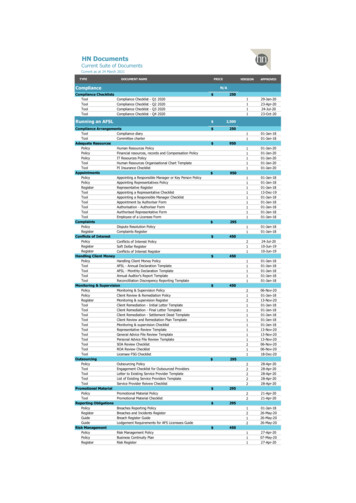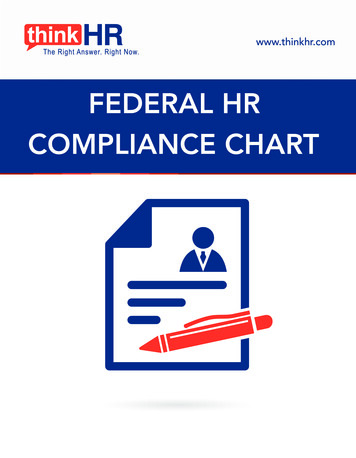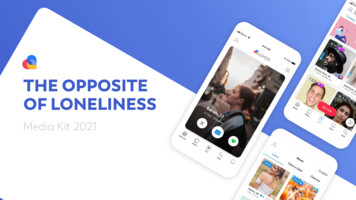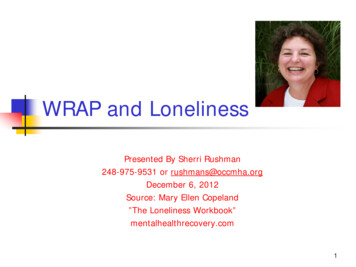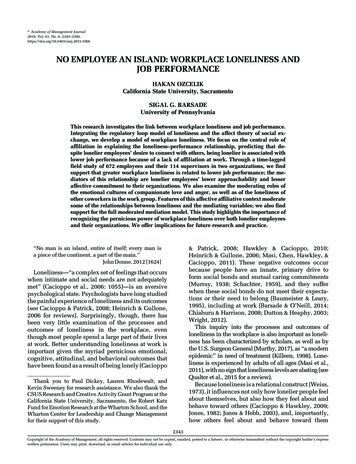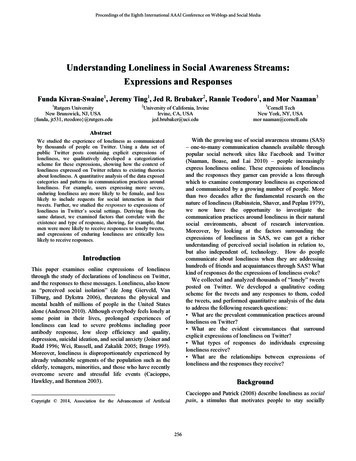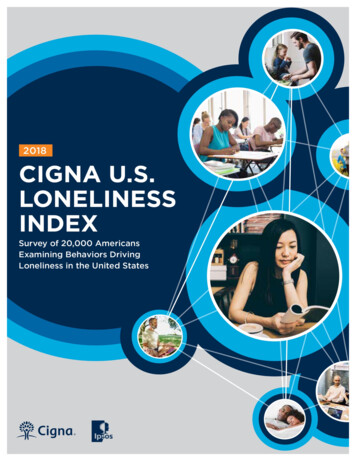
Transcription
May 2018Dear Colleagues,As a global health service company, Cigna understands the importance of looking at health and well-beingacross physical, mental and social needs. As part of that commitment, we regularly evaluate ourselves, ourhealth care systems and our communities to gain even greater insights into the health and well-being of ourcustomers and communities, identify any gaps in the health care system, and address emerging issues thataffect the people we serve.Approximately 1 in 6 adults in the U.S. suffer from a mental health condition, and research has noted thatmental health issues are one of the most rapidly increasing causes of long-term sick leave. When examiningthe different issues affecting people with mental health conditions, there is a consistent part of the pathology:they also suffer from loneliness.Loneliness has the same impact on mortality as smoking 15 cigarettes a day, making it even more dangerousthan obesity.In partnership with Ipsos, Cigna conducted an online survey of more than 20,000 U.S. adults 18 yearsand older using the UCLA Loneliness Scale to further examine loneliness in America. We found that mostAmericans are considered lonely.The study revealed: Generation Z (adults ages 18-22) and Millennials (adults ages 23-37) are lonelier and claim to be in worsehealth than older generations. Social media use alone is not a predictor of loneliness. Students have higher loneliness scores than retirees. There was no major difference between men and women and no major difference between races when itcame to average loneliness scores.The research also highlighted some bright spots that will be instrumental in driving change. It showed thatindividuals who are less lonely are more likely to have regular in-person interactions, are in good overallphysical and mental health, have found a balance in their daily activities, and are employed.At Cigna, we know our work to combat this issue has just begun. But we’re motivated by the fact that these resultspoint to the benefits meaningful in-person contact can have on loneliness. We are dedicated to providingresources to address the loneliness epidemic and improve Americans’ overall mental wellness and vitality.To learn more about the survey, our efforts to drive greater connections in our society, and our existingprograms to address loneliness, please click here.Sincerely,Douglas Nemecek, M.D., MBAChief Medical Officer for Behavioral Health, Cigna2
AMERICAN ADULTS ARE CONSIDERED LONELY,AS REVEALED BY NEW CIGNA STUDYIn February 2018, Cigna partnered with Ipsos to better understand the state of loneliness in America. Usingquestions based on UCLA’s Loneliness Scale - a frequently referenced and acknowledged academic measureused to gauge loneliness - the Cigna Loneliness Index survey was created to focus the national conversationon the epidemic.The survey was fielded among more than 20,000 U.S. adults ages 18 and older. The formula behind the indexinvolves deriving a score for each respondent based on their answers to a series of twenty statements andfrom there calculating a total mean score for everyone who completed the survey to obtain a national score.The index stipulates that the higher the score, the lonelier people are. Possible loneliness scores range from20 to 80, with the total average national loneliness score in America reaching 44. Total average lonelinessscores were also analyzed across different demographic groups of interest to gauge which populations aremost susceptible to experiencing feelings of loneliness.This report features an in-depth look at some interesting differences that emerge across demographics,while also comparing results from key regions, as well.According to the survey, many Americans experience feelings of loneliness, including: When asked how often they feel like no one knows them well, more than half of the respondents (54%)surveyed said they feel that way always or sometimes. Just under half of all those surveyed report sometimes or always feeling alone (46%) and/or feelingleft out (47%). At least two in five surveyed sometimes or always feel as though they lack companionship (43%), that theirrelationships are not meaningful (43%), that they are isolated from others (43%), and/or that they are nolonger close to anyone (39%).3
Approximately six in ten (59%) surveyed always/sometimes feel that their interests and ideas are not sharedby those around them. A similar proportion surveyed reports sometimes or always feeling like the people around them are notnecessarily with them (56%). Though fewer feel as though there is no one they can turn to, more than a third of the respondents1nevertheless report feeling this way at least sometimes (36%).We also see that roughly one in four respondents rarely/never feel as though there are people who reallyunderstand them (27%), that they belong to a group of friends (27%), can find companionship when theywant it (24%), or again feel as though they have a lot in common with others (25%). Another one in five rarely,if ever, report feeling close to people (20%) or ‘in tune’ with others (21%), while similar proportions don’t feelas though there are people they can turn to (19%) or talk to (18%). Another 16% of those surveyed admit thatthey rarely/never feel outgoing and friendly.Throughout the report, the analysis/data included to illustrate the proportion of respondents who agree/experience different feelingsregarding the twenty individual statements reflect total results for those who say they ‘Always/Sometimes’ feel this way, while referencesmade to those who do not agree/do not feel this way reflect combined results for those who say they ‘Never/Rarely’ feel this way.14
THERE ARE CONSISTENT TRAITS THATDISTINGUISH LONELY AND LESS LONELYINDIVIDUALSWhen comparing results for those who are lonelier versus those who are less lonely, consistent traitsbegin to emerge that can be connected to one’s level of loneliness. It was found that lonelier people aremore likely to have infrequent in-person interactions, disagree that their “social skills”/relationshipstatuses are good, be in fair/poor overall, physical, and mental health, and have less balance in theirlives – all of which are interconnected and come with repercussions of their own. Some interesting pointsthat arise here include: Of those respondents who never have in-person interactions, half (50%) are in fair/poor overall health,whereas just 12% of those who have daily in-person interactions are in fair/poor overall health. Themajority of those who never have in-person interactions also report being in fair/poor physical health (52%,vs. 23% of those who have daily interactions) and mental health (51% vs. 12%). Those who never have in-person interactions are also less likely to have “balance” in their lives, withonly 36% saying they get the right amount of sleep (vs. 50% of those who have daily in-personinteractions) and 37% saying they get the right amount of family time (vs. 65%). Directly connected with this, we see that daily interactions are less common among those in fair/poorhealth, with 31% of respondents in fair/poor overall health experiencing daily in-person interactions (vs.58% of those in good, very good or excellent overall health) and 41% of those in fair/poor physical healthsaying they interact with others daily (vs. 58% of those in good, very good or excellent physical health). Asimilar pattern is seen when it comes to mental health, with those reporting fair/poor mental health muchless likely to experience in-person interactions versus those in good, very good or excellent health (32% vs. 58%). Those respondents in fair/poor health also report greater difficulties in achieving balance in their lives,including: Only a third (33%) of those in fair/poor overall health are getting the right amount of sleep (vs. 51% ofthose in good, very good or excellent overall health), while 38% of those in fair/poor overall healthreport working for the right amount of time (vs. 57% of those in good, very goodor excellent overall health). Additionally, we see that those respondents who are not content with their relationships have a lonelinessscore of 54.3 – more than 13 points higher than those who agree they are content with their relationships(40.7). These adults who are not content with their relationships are also more likely to report being infair/poor overall health (42% vs. 12% of those who are content with their relationships).Importantly, the opposite holds true for those respondents who are less lonely, with this group more likely tohave frequent meaningful in-person interactions, agree their “social skills”/relationship statuses are good, bein good health overall (including physical and mental health), and display greater balance in their lives.5
GEN Z (ADULTS AGES 18-22) IS THELONELIEST GENERATION AND SOLITUDEIS SEEN TO LESSEN WITH AGELoneliness scores differ when analyzed across age/generations. Gen Zers (adults ages 18-22) surveyed have atotal average loneliness score of 48.3 – granting them the title of the loneliest generation – while scoresgradually drop as respondents continue to age, culminating in a total average loneliness score of 38.6 forthe least lonely group, the Greatest Generation (adults ages 72 ).Generation Zers (adults ages 18-22) surveyed are significantly more likely than any other generation to saythey experience the feelings described in the statements associated with loneliness (e.g., feeling alone,isolated, left out, that there is no one they can talk to, etc.). In fact, more than half of Gen Zers (adults ages18-22) identify with 10 of the 11 feelings associated with loneliness. Feeling like people around them are notreally with them (69%), feeling shy (69%), and feeling like no one really knows them well (68%) are among themost common feelings experienced by those in the Generation Z (adults ages 18-22).Millennials (adults ages 23-37) and Gen Xers (adults ages 38-51) surveyed follow this pattern, though notquite to the same extent, with similar proportions among these two audiences saying they experience feelingsassociated with loneliness. We see feelings of loneliness gradually continuing to fall when looking at Boomers.Those making up the Greatest Generation (adults ages 72 ) are least likely to report having feelings ofloneliness, such as lacking companionship (30%), feeling alone (30%), feeling left out (28%), and feeling asthough they have no one they can turn to (18%). However, fewer major differences emerge across allgenerations when it comes to feeling as though their interests and ideas are not shared by those around them,with a majority of Gen Zers (adults ages 18-22), Millennials (adults ages 23-37), Gen Xers (adults ages 38-51),Boomers (adults ages 52-71), and those making up the Greatest Generation (adults ages 72 ) reporting theyfeel this way at least sometimes.6
When looking at feelings that are not associated with being lonely, adults from the Greatest Generation (adultsages 72 ) surveyed are most likely to feel in tune with others (92%), feel close to other people (92%), and feellike there are people they can both turn to (92%) and talk to (92%). Adults aged 72 and older are alsosignificantly more likely to consider themselves as being friendly and outgoing (94% vs. 75% of Gen Z). GenZers (adults ages 18-22) fall to the bottom as the generation that is least likely to feel the ways described bythe 9 statements below.7
THOSE WHO ENGAGE IN FREQUENT MEANINGFULIN-PERSON INTERACTIONS HAVE MUCH LOWERLONELINESS SCORES THAN THOSE WHO RARELYINTERACT WITH OTHERS FACE-TO-FACEIn-person interactions play an important role in alleviating one’s feelings of loneliness, with those whoexperience infrequent in-person interactions typically much lonelier than those who engage in meaningfulinteractions regularly. When asked how frequently they have meaningful in-person social interactions (e.g.,having an extended conversation with a friend, spending quality time with family), most respondents reportconnecting with others at least daily (53%). Twenty-nine percent report having meaningful interactions on aweekly basis, while just under one in ten (8%) report having these types of exchanges monthly. However,meaningful in-person socializing occurs even less often for the remaining one in ten (10%), including a few(2%) who say they never engage with others.When profiling those who have daily in-person interactions, data shows that these adults are significantlymore likely to say their overall health is good, very good or excellent, with 88% of those having daily in-personinteractions saying their overall health is good, very good or excellent compared to 50% of those who neverhave in-person interactions. This group is also significantly more likely to say their mental health is good, verygood or excellent (88% vs. 49% of those who never have in-person interactions) and to report having balancewhen it comes to different areas of their lives (sleep, work, etc.), with half (50%) of those having daily inperson interactions getting the right amount of sleep versus 36% of those who never havein-person interactions.When looking at how loneliness scores vary across those with different levels of in-person interaction, resultsshow that those who have daily in-person interactions have the lowest total average lonelinessscore (39.6), while the few who report never interacting with others have an average loneliness scorethat is 20 points higher (59.6). This trend illustrates that loneliness will typically decrease as in-personinteraction increases.8
In fact, when looking at responses to the individual statements used to calculate the overall loneliness scores,those who say they engage in meaningful social interactions multiple times a day/daily are significantly lesslikely to feel as though they lack companionship, that there is no one they can turn to, that they are no longerclose to anyone, that no one really knows them well, and that the people around them are not actually ‘with’them – especially when compared to those who interact with others only on a monthly/annual basis. Thosewho experience daily in-person interactions are also significantly less likely to report feeling isolated, alone,left out, and shy.It is interesting to note that while feelings associated with loneliness resonate highly with those who say theynever have meaningful in-person social interactions with others, they don’t always have the highest scorewhen it comes to always/sometimes experiencing these feelings. However, those who never have in-personinteractions are more likely than other segments to report feeling as though they are no longer close toanyone and that they have no one they can turn to. They are on par with those who interact with others everyother month to yearly when it comes to feeling as though they lack companionship.When it comes to feelings that are not associated with being lonely, those surveyed who experience dailymeaningful in-person interactions are significantly more likely to feel as though there are people they can turnto (90%), people they can talk to (91%), and people who understand them (84%) – especially compared to thosewho say they never interact with others (31%, 32%, and 28%, respectively). Those who socializewith others daily are also significantly more likely to feel as though they belong to a group of friends (85% vs.21% of those who never interact with others), have a lot in common with others (85% vs. 28%), and are close topeople (90% vs. 29%). They are also most likely to describe themselves as being outgoing and friendly (90%).9
10
FAIR OR POOR PHYSICAL HEALTH CAN BE ANINDICATOR OF INCREASED LONELINESSA person’s health is yet another factor that is seen to influence feelings of loneliness, with lonelinessincreasingly more prevalent as self-reported overall health drops. When asked to rate their overall health andwell-being (physical, social, family, financial, work related), most respondents say they are in good health –including one in ten (12%) who report being in excellent health, a third (34%) who claim they are in very goodhealth, and another 34% who rate their overall health as good. On the other hand, one in five (19%) claim thattheir health is either fair or poor.When looking at loneliness scores across health ratings, results show that those who rate their health asfair/poor have a loneliness score that is nearly 11 points higher than those who rate their health as beinggood/very good/excellent (52.8 and 41.9, respectively). This gap grows to 13.5 points when comparingthose who rank their health as being fair/poor against those who fall into the top two health brackets (39.3,excellent/very good).Looking specifically at physical health, a similar pattern emerges with those in good/very good/excellentphysical health obtaining a loneliness score of 41.6, 8 points lower than those in fair/poor health (49.6). Thistrend holds true when it comes to mental health, with those who feel good, very good or excellent about theirmental health (41.6) obtaining a loneliness score that is nearly 13 points lower than those who rate theirmental health as fair or poor (54.5). It was also found that fewer respondents in fair/poor overall health havedaily in-person interactions (31%) compared to the 58% of those in good, very good or excellent overall healththat have daily in-person interactions.The Greatest Generation (adults ages 72 ) is most likely to say their overall (84%), physical (77%), and mentalhealth (94%) is good, very good or excellent. Gen Z (adults ages 18-22), the loneliest generation, is least likelyto say the same about their own overall (76%), physical (65%) and mental health (65%).NATIONAL RESULTSTHOSE IN FAIR/POOR HEALTH ARE MORE LIKELYTO BE ent/Very GoodHealth206070303080Excellent/VeryGood/Good Health8020Fair/PoorHealth111
Respondents who rate their overall health as being fair/poor are up to twice as likely to say they experienceemotions associated with loneliness, such as feeling left out, alone, or isolated compared to those inexcellent/very good health who say the same thing.Though the differences identified across each segment are not as pronounced when it comes to feelings thatare not associated with being lonely, these statements are significantly more likely to resonate with those inbetter health. This includes a greater proportion of those who rate their health as being excellent/very goodthat describe themselves as being outgoing and friendly (90% vs. 70% of those with fair/poor health) and asubstantially greater proportion of healthy adults who also report feeling that there are people they can talk to(90% vs. 62%) or turn to (89% vs. 62%). Healthy adults are also much more likely to report feeling close to otherpeople (89% vs. 59%).12
OTHER LIFESTYLE FACTORS, INCLUDING SLEEPPATTERNS, HOW MUCH YOU WORK, AND HOWMUCH TIME YOU SPEND WITH FAMILY ARE ALSOTIED TO LONELINESSBalance is key when it comes to keeping feelings of loneliness at bay – and this is true when looking at howmuch people sleep, work, socialize, and exercise.Looking specifically at the impact that sleep can have on loneliness, those surveyed who say they sleep justthe right amount have the lowest loneliness score – falling 4 points behind those who sleep less than desiredand 7.3 points behind those who sleep more than desired.When looking at responses to the individual statements used to calculate the overall loneliness scores, thosewho say they sleep just the right amount are significantly less likely to feel as though they lack companionship(37% vs. 62% of those who oversleep), are isolated from others (36% vs. 62%), that there is no one they canturn to (29% vs. 56%), that they are no longer close to anyone (31% vs. 60%), and that no one really knowsthem well (47% vs. 69%). Those who get the perfect amount of sleep are also significantly less likely to reportfeeling alone, left out, and shy.13
Taking a closer look at feelings that are associated with not being lonely, those who say they sleep just theright amount score highest this time, with significantly greater proportions describing themselves as beingoutgoing and friendly (87% vs. 75% of those who sleep more than desired) and feeling as though there arepeople they can talk to (86% vs. 74%) or turn to (85% vs. 71%). Those who sleep less than desired follow thispattern, though not quite to the same extent, while those who oversleep are least likely to report havingfeelings that are associated with not being lonely.14
Spending time with family also plays an important role in alleviating one’s feelings of loneliness, with toomuch or too little time spent with loved ones leading to loneliness scores that are higher than those who saythey spend just the right amount of time with family.Those surveyed who say they spend more time than desired with their family and those who spend less timethan desired are on par with one another when it comes to experiencing feelings of loneliness, while thosewho say they spend just the right amount of time with family are less likely to have such feelings.Feelings that are associated with not being lonely resonate most with those who say they spend just the rightamount of time with their loved ones – while those spending too much/not enough time with family tend to beless likely to describe having such feelings. However, despite consistently falling behind those who spend theright amount of time with family, those who report spending too much time with family do stand out as being15
more likely than those who don’t to say that they feel as though they are part of a group of friends (73% vs.64%), they have a lot in common with others (71% vs. 66%), they can find companionship when they need it(74% vs. 67%), and that there are people they can talk to (78% vs. 74%).Another lifestyle factor which impacts loneliness is physical activity, with those who say they get just the rightamount of exercise considerably less likely to be lonely. Relative to that group, the loneliness score of thosewho exercise more than desired increases by 3.5 points, while a similar uptick is seen for those who exerciseless than desired (up 3.7 points).16
Feelings of loneliness are likely to affect both those who exercise too much and those who don’t exerciseenough in a similar way, while fewer people who say they get just the right amount of physical activityexperience feelings of loneliness.The opposite is true when it comes to feelings associated with not being lonely (e.g., feeling there are peopleyou can turn to, feeling close to people, etc.), with those exercising the perfect amount more likely to reportexperiencing such feelings. In some cases, those who say they exercise more than desired fall in line withthose exercising for just the right amount, including similar proportions across these two groups who reportfeeling as though they are part of a group of friends (79%, each), have a lot in common with others (75% ofthose who exercise more vs. 79% who exercise just right), and can find companionship when they want it (76%vs. 80%).17
Different living situations also impact loneliness levels. Those living with others are less likely to be lonely(43.5) compared to those living alone (46.4), though single parent/guardian homes are the loneliest (48.2).18
RETIREES ARE LEAST LIKELY TO BE LONELY,FOLLOWED CLOSELY BY EMPLOYED ADULTSLooking at the effects of one’s employment status on loneliness, it is interesting to note that both thosesurveyed who are employed (43.7) and those who are retired (41.2) tend to be the least lonely. Lonelinessstarts to increase when looking at homemakers (44.9) and surges even higher when it comes to students(47.9). However, it appears that forced unemployment is the greatest driver of loneliness, with those whoare unemployed being especially likely to demonstrate experiencing feelings of loneliness (49.1).Adults surveyed who are unemployed (versus the other groups) are significantly more likely to say that theyexperience feelings of loneliness, including roughly two-thirds who feel no one really knows them well (68%),that the people around them are not ‘with’ them (67%), that their interests/ideas are not shared with others(65%), and that they feel alone (65%).Students surveyed mirror this pattern, with a majority in agreement with many of the statements associatedwith loneliness – though adults from this category surpass adults from all other employment groups when itcomes to feeling like the people around them are not always with them (69%), feeling shy (74%), and feelingleft out (64%). Retirees, employed adults, and homemakers, in their turn, do not typically feel such lonelyemotions to quite the same extent. Feelings that are not associated with being lonely resonate best withretirees, with more than eight in ten in agreement with most of the statements included.19
Cigna’s efforts to tackle the loneliness epidemic20
THE WORKPLACE PLAYS A ROLE IN LONELINESSWhen it comes to work-life balance, those surveyed who say they work just the right amount are least likelyto be lonely. The loneliness score of those who work more than desired increases by just over 3 points, whilethose who work less than desired display a 6-point increase in loneliness.Furthermore, one’s quality of relationships with their coworkers also impacts overall health and wellness,with those who agree their coworker relationships are good, very good or excellent are significantly morelikely to be in good, very good or excellent overall health (89% vs. 65% of those with fair/poor relationshipswith coworkers).Respondents who say they work less than desired are significantly more likely to experience feelingsassociated with loneliness, including feeling as though people around them are not with them (67% vs. 49%of those who say they work just the right amount), that no one really knows them well (66% vs. 48%), andthat their interests and ideas are not shared by those around them (66% vs. 54%).21
Conversely, those who report working less than desired are also less likely to report having feelings associatedwith being less lonely (e.g., feeling outgoing and friendly, there are people you can talk to, etc.), compared toboth those who say they work more than desired and those who say they work just theright amount.22
SOCIAL MEDIA USE IS NOT A PREDICTOR OFLONELINESSLevels of in-person interactions, physical and mental wellness and life balance are more likely to predictloneliness than social media usage. For instance, those respondents defined as very heavy users of socialmedia have a loneliness score (43.5) that is not markedly different from the score of those who never usesocial media (41.7).23
CIGNA U.S. LONELINESS INDEXREPORT: REGIONAL PROFILES24
REGIONAL PROFILESHOUSTON, TX (HOUSTON-THE WOODLANDS-SUGAR LAND, TX)Houston residents are more likely to be lonely than other Americans. Around 60 percent of Houstonresidents are considered to be lonely, compared to roughly 54 percent of the national population. Acrossdemographics, the survey found that younger Houstonians (ages 18-34) have an average loneliness score3.9 points higher than 35-54-year-olds in the area (47.1 vs. 43.2). Single adults in Houston were also foundto have higher loneliness scores than married adults (47.2 vs. 43.4).The survey also found: Almost half (48 percent) of Houstonians say they sometimes or always feel alone. More than half (51 percent) of Houston residents say they sometimes or always feel left out. Six out of ten (61 percent) Houston residents say they sometimes or always feel that no one knows themwell. Almost a third (29 percent) of Houston residents say they rarely or never feel like there are people whoreally understand them. Nearly half (45 percent) of Houston residents sometimes or always feel that their relationships with othersare not meaningful.The survey revealed that having a supportive network is essential to being less lonely. For instance,Houston residents who don’t feel they have enough people they can turn to for help have an averageloneliness score 10.5 points higher than those who have enough people they feel comfortable asking for help(52.2 vs 41.7). Similarly, those who find it difficult to approach others have an average loneliness score 9.6points higher than the score of those who don’t find it difficult to approach others (50.9 vs. 41.3).25
Family life and social life are part of this supportive network, also impacting loneliness. Houston residentswho describe their family life as fair or poor have an average loneliness score 11.8 points higher than thosewho describe their family life as good, very good or excellent (54.5 vs. 42.7). Similarly, Houstonians who ratetheir social life (friends and hobbies) as only fair or poor have an average loneliness score 13.6 points higherthan those who rate their social life as good, very good or excellent (53.5 vs. 39.9). Not surprisingly, thosewho are unhappy with their relationships have an average loneliness score that is 13.3 points higher thanthose who are happy with their relationships (54.9 vs. 41.6). But finding the right balance is still important. Those in Houston who say they spend too much or toolittle time with family have an average loneliness score nearly 9 points higher than those who get just theright amount of family time (50.2 vs. 41.3).Mental health also plays a role. Those in Houston who say their mental health is fair or poor have an averageloneliness score 12.5 points higher than those who say their mental health is good, very good or excellent(55.2 vs. 42.7).26
REGIONAL PROFILESAUSTIN, TX (AUSTIN-ROUND ROCK, TX)Around 60 percent of Austin residents are lonely versus roughly 54 percent of the national population.Acros
Loneliness scores differ when analyzed across age/generations. Gen Zers (adults ages 18-22) surveyed have a total average loneliness score of 48.3 – granting them the title of the loneliest generation – while scores gradually drop as respondents continue to age, culminating in a to
